It looks like you're using an Ad Blocker.
Please white-list or disable AboveTopSecret.com in your ad-blocking tool.
Thank you.
Some features of ATS will be disabled while you continue to use an ad-blocker.
21
share:

At 12.10 pm on 24 May 1971, celebrated Argentinean painter Professor Julio Suarez Marzal (above) was with his dentist, Dr Walter Griehl, in the latter’s surgery in the centre of Mendoza, Argentina. It was a fine sunny day. Looking out of a south-facing window, they both saw a plato volador (flying saucer) moving westwards.
Marzal estimated the craft was travelling at a height of above 1000 metres, Dr Griehl estimated 1500 metres. While Dr Griehl rushed away to get binoculars, the craft descended to a point only about 40 metres from Marzal. Marzal noticed what he called a visor (viewfinder) attached to the UFO. He observed the now nearby UFO aiming its visor towards a set of parabolic antennas on top of the nearby Post Office building, rolling around as it did so:
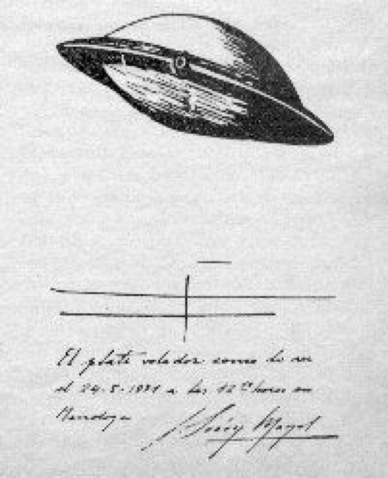
Marzal’s drawing of the UFO close up, deploying its visor.
Marzal observed the UFO in Dr Griehl’s surgery, looking southwards through the window.
The UFO’s visor (image capture device. as explained later) is pointing to an array of parabolic antennae on the top of the Post Office building in Mendoza (see map below).
Marzal’s drawing is the most convincing close-up study of a UFO that I’ve seen. The noon end-May sun at Mendoza (latitude 33 degrees south) would be due north an about 37 degrees above the horizon, I think. Professor Marzal shows the sun illuminating both top and bottom bowls of the disc exactly as it should. He shows the shadow of the UFO’s projecting Saturn-like disc and the shadow of the visor. A streak of light to the left of the visor seems to originate in a hole in the Saturn-like disc, which could have been caused by passage of a micrometeorite through the disc.
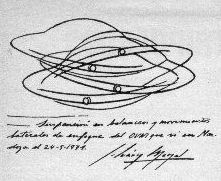
Point and shoot. Marzal’s drawing of the UFO’s rocking motion as it pointed its visor towards the parabolas.

Above. Local map of Mendoza, showing Post Office building with parabolic antennas, the witnesses (Marzal and Griehl) and the UFO.
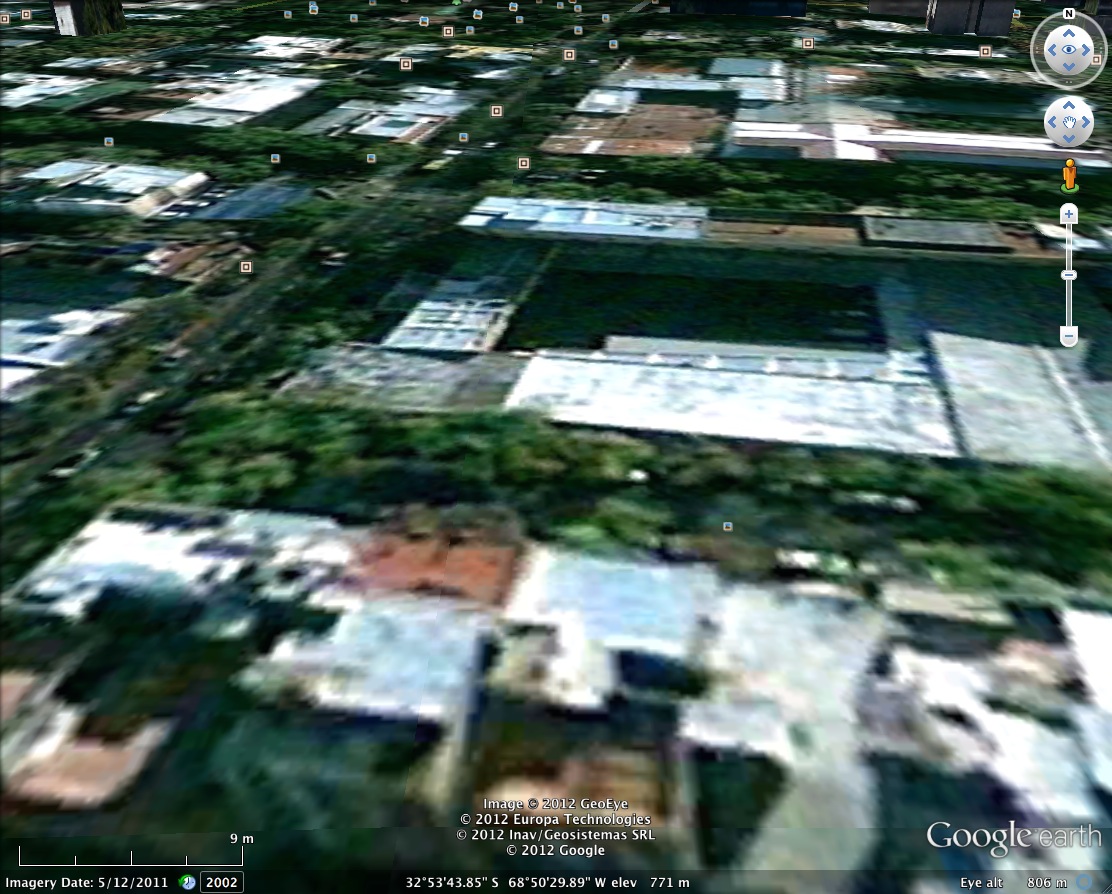
The antennas, or their later replacements are still there (above).
One of the most intriguing of Marzal’s observations concerns the UFO's deployment of its visor. Below is his sketch of this device:
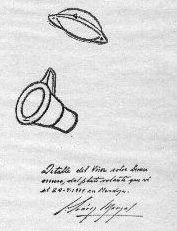
The tubular finlike projection on top looks like a handle and I think the whole object may have been a portable unit, consisting of a conical lens hood or sun shield (left) attached to a cylindrical image capture and storage device. Marzal estimated the diameter of the cylinder to be about 8 cm.
Below is Marzal’s interpretation, in section and plan, of the visor in position on the UFO. All dimensions are estimates.
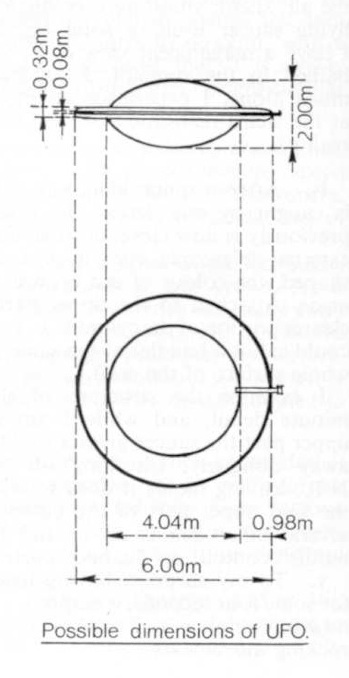
Professor Marzal evidently imagined the visor as part of a long telescope-like unit extending to the UFO’s interior. He may even have imagined a small alien pilot inside the UFO peering through the telescope’s eyepiece.
But small aliens with long telescopes don’t impress me.
In any case a telescope-like unit would have too limited a field of view for the craft to accomplish the navigation and surveillance feats that Marzal described and illustrated. IMO it’s more likely that the UFO’s image capture device was a portable wide-angle unit temporarily attached to its exterior (see below)
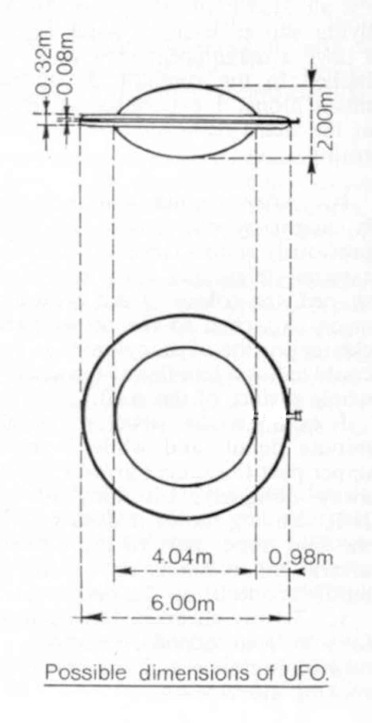
Professor Marzal’s section and plan of the UFO, modified by Lowneck to show suggested attachment of small image capture device instead of long telescope. The device would link to the craft’s computers, and would allow room within the disc for a momentum wheel or other gyroscopic or propulsion device.
A robot on board the UFO’s mother ship or at its putative Solar System base could have used the handle to fit the image capture and storage device plus lens hood onto the UFO before the daylight surveillance mission began. Alternative devices, perhaps involving IR sensors or emitting powerful electromagnetic beams, could have been fitted to the craft for nighttime surveillance missions.
In all missions, the UFO’s computers might use imagery acquired by the fitted devices for real-time navigation. Effectively the craft would rely on a single ‘eye’ and that might explain its tumbling motion as it descended towards its target objects on the Post Office building in Mendoza.
We can imagine this ‘tumbling’ one-eyed craft heading west about 1000 metres above the Mendoza area, its computers continually comparing new imagery with stored images of significant human technology, particularly emerging space technology. Intelligently, it identified the parabolic antennas on the Post Office building as ‘interesting’ – after all contemporary human space probes had parabolic antennas - and the UFO decided to acquire close-up imagery.
It’s even possible that the UFO monitored microwave radio frequency transmissions from the antennas, and this information played a part in its decision.
By the time Dr Griehl returned to his surgery with binoculars, the UFO had disappeared. But he signed an affidavit, as quoted in this link:
www.ignaciodarnaude.com...
Not wanting ridicule, Professor Marzal did not publicise his sighting in the Mendoza press. But he understood the scientific importance of his observations and allowed articles to appear later in the UFO journals Revista Exo (No 2), Lumieres dans la Nuit and Flying Saucer Review.
As a result of the lack of publicity at the time there was no incentive for other witnesses in Mendoza to come forward. It’s possible that there were some military witnesses, but I’ve not been able to find confirmation of this. It’s not too late even now for other witnesses to come forward.
Conclusions:
Thanks presumably to his toothache, Professor Marzal gave us what seems to be a unique account of a ‘daylight disc’ using an image capture device fitted with a sun shield to study parabolic antennas in Mendoza, Argentina in full midday sunlight in May 1971.
Given that humans were then using parabolic antennas both in terrestrial tracking stations, such as those of NASA’s Deep Space Network, in space probes and missile tracking, Marzal's 1971 observation of a UFO ignoring all else and zooming down to study the Mendoza parabolic antennas is highly significant.
It’s understandable that in 1971 Marzal might think of a small alien with a long telescope. But now that we all know something about digital image capture devices, we can make better sense of his observations.
That doesn’t mean that the ET image capture device had a glass compound lens like a human camera's. All we can assume is that the device gathered information from the abundant solar photons reflected from the target objects. Glass compound lenses have limitations – for example they only transmit photons of certain energies. I’d guess ET technology deployed in 1971 could extract more information from reflected solar photons than human technology can today.
links and sources
www.ignaciodarnaude.com...
(in Spanish)
dragoninvisible.com.ar...
Great work!
Fantastic report!
Thank you.
At first mention of both the witnesses hanging out in the surgery room, my initial thought was there might be an angle of explanation regarding either single, or even shared recreational use of NO2, especially what with it being the 1970s.
The level of detail and reporting on follow up, with dual verification validating each others' sighting lowers speculation of probability for this.
Very interesting.
Too bad more artists, or people skilled in media like photography don't capture these things either in reproduction like this artist did, or with professional level precision equipment used by well trained and experienced artists or tradesmen with photography, news media, or even entertainment film.
Wonderful stuff.
Fantastic report!
Thank you.
At first mention of both the witnesses hanging out in the surgery room, my initial thought was there might be an angle of explanation regarding either single, or even shared recreational use of NO2, especially what with it being the 1970s.
The level of detail and reporting on follow up, with dual verification validating each others' sighting lowers speculation of probability for this.
Very interesting.
Too bad more artists, or people skilled in media like photography don't capture these things either in reproduction like this artist did, or with professional level precision equipment used by well trained and experienced artists or tradesmen with photography, news media, or even entertainment film.
Wonderful stuff.
reply to post by Lowneck
Good find L
I thought I'd read all the FSRs and this one is totally new to me.
Naturally, it's worth looking for any allegations of hoax or history of outlandish claims. I've had a brief look (google translate on overtime) and haven't found anything that implicates him as a dubious witness.
The account is remarkably detailed and specific and that pokes at my suspicious nature slightly. On the other hand, if he really saw what he claimed to have seen, it's no surprise that a gifted artist would be able to capture the object in his sketches.
This is one of his paintings and it reminds me a little of Edvard Munch's style...

I'll read the article more thoroughly and just wanted to post this as a thanks for bringing something new to the subject. I've said it before, but you're a member worth watching out for...quality posts.
Here's another image from the article showing his rendition of the object's motions...
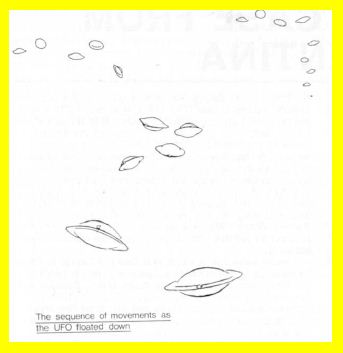
I thought I'd read all the FSRs and this one is totally new to me.
Naturally, it's worth looking for any allegations of hoax or history of outlandish claims. I've had a brief look (google translate on overtime) and haven't found anything that implicates him as a dubious witness.
The account is remarkably detailed and specific and that pokes at my suspicious nature slightly. On the other hand, if he really saw what he claimed to have seen, it's no surprise that a gifted artist would be able to capture the object in his sketches.
This is one of his paintings and it reminds me a little of Edvard Munch's style...

I'll read the article more thoroughly and just wanted to post this as a thanks for bringing something new to the subject. I've said it before, but you're a member worth watching out for...quality posts.
Here's another image from the article showing his rendition of the object's motions...

I really like these old cases and this one is new to me as well , but something about this case just doesn't feel right , can't put my finger on it
though .
Anyway I've done some digging around and found little to no info that hasn't already been posted , but I may have an explanation .
If we put the E.T.Hypothesis aside and look for terrestrial suspects there may be one in the EOLE Project that started in Argentina in October 1968 .
EOLE balloon launch from Neuquen, Argentine Republic

The picture drawn by Marzal shows the "visor" being deployed from underneath the craft , could this picture (from 1.42 on video) be the Visor .

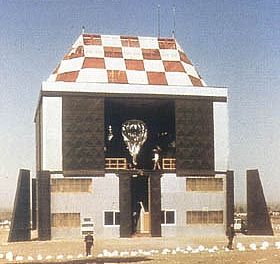
Now I know the dates don't quite match up but I assume they would of conducted tests before it got into full swing .
I'm not saying that this is what was seen , but food for thought maybe
Anyway I've done some digging around and found little to no info that hasn't already been posted , but I may have an explanation .
If we put the E.T.Hypothesis aside and look for terrestrial suspects there may be one in the EOLE Project that started in Argentina in October 1968 .
In October 1968, a committee of French studies visited the airport to conduct a survey and trace maps and planes, planning to carrying out a bi-national project called EOLO that involved launching from three bases in Argentina, small superpressure balloons which would be interrogated by a satellite during its flight.
EOLO Mendoza was the first of three stations built. The other two were established at the airport in the province of Neuquen and in Lago Fagnano (Tierra del Fuego), respectively.
stratocat.com.ar...
EOLE balloon launch from Neuquen, Argentine Republic

The picture drawn by Marzal shows the "visor" being deployed from underneath the craft , could this picture (from 1.42 on video) be the Visor .

Given the characteristics of the materials, the station was built very rapidly so that by early 1970 was almost complete. It was formally inaugurated on March 15, 1970, with the presence of authorities of the Provincial Directorate of Aeronautics and both space agencies. The launch operations began with a frequency of four balloons per day in July 1971 and continued for the rest of that year, and part of next.
stratocat.com.ar...

Now I know the dates don't quite match up but I assume they would of conducted tests before it got into full swing .
I'm not saying that this is what was seen , but food for thought maybe
edit on 23-1-2012 by gortex because: Edit to add
reply to post by Kandinsky
Kandinsky,
Much appreciate your comments - and the picture by Marzal.
Apparently he made some colour paintings of his plato volador sighting. Sadly he died the year afterwards..
Can't even imagine how Professor Marzal and Dr Griehl would have organised a hoax, let alone why they would have done so. And I think it's telling that the pair avoided local publicity yet understood how important it was scientifically.
Cheers.
Kandinsky,
Much appreciate your comments - and the picture by Marzal.
Apparently he made some colour paintings of his plato volador sighting. Sadly he died the year afterwards..
Can't even imagine how Professor Marzal and Dr Griehl would have organised a hoax, let alone why they would have done so. And I think it's telling that the pair avoided local publicity yet understood how important it was scientifically.
Cheers.
reply to post by gortex
Gortex,
Very interesting theory - apart from hoax the balloon theory seems the best alternative to ET so far.
But IMHO a balloon couldn't possibly have performed the manouevres Marzal described and a brilliant observer like Marzal couldn't have mistaken a balloon for a flying saucer only 40 metres away in midday sunlight.
In fact you could turn the argument round and suggest that the setting up of the Mendoza EOLO station near Mendoza from 1970 may have been one of the factors that prompted ET interest in the area.
Cheers - and thanks for digging around.
Gortex,
Very interesting theory - apart from hoax the balloon theory seems the best alternative to ET so far.
But IMHO a balloon couldn't possibly have performed the manouevres Marzal described and a brilliant observer like Marzal couldn't have mistaken a balloon for a flying saucer only 40 metres away in midday sunlight.
In fact you could turn the argument round and suggest that the setting up of the Mendoza EOLO station near Mendoza from 1970 may have been one of the factors that prompted ET interest in the area.
Cheers - and thanks for digging around.
new topics
-
Ditching physical money
History: 55 minutes ago -
One Flame Throwing Robot Dog for Christmas Please!
Weaponry: 1 hours ago -
Don't take advantage of people just because it seems easy it will backfire
Rant: 1 hours ago -
VirginOfGrand says hello
Introductions: 2 hours ago -
Should Biden Replace Harris With AOC On the 2024 Democrat Ticket?
2024 Elections: 2 hours ago -
University student disciplined after saying veganism is wrong and gender fluidity is stupid
Education and Media: 5 hours ago -
Geddy Lee in Conversation with Alex Lifeson - My Effin’ Life
People: 6 hours ago -
God lived as a Devil Dog.
Short Stories: 6 hours ago -
Police clash with St George’s Day protesters at central London rally
Social Issues and Civil Unrest: 8 hours ago -
TLDR post about ATS and why I love it and hope we all stay together somewhere
General Chit Chat: 9 hours ago
top topics
-
Hate makes for strange bedfellows
US Political Madness: 11 hours ago, 18 flags -
Who guards the guards
US Political Madness: 14 hours ago, 13 flags -
University student disciplined after saying veganism is wrong and gender fluidity is stupid
Education and Media: 5 hours ago, 10 flags -
Police clash with St George’s Day protesters at central London rally
Social Issues and Civil Unrest: 8 hours ago, 8 flags -
TLDR post about ATS and why I love it and hope we all stay together somewhere
General Chit Chat: 9 hours ago, 7 flags -
Should Biden Replace Harris With AOC On the 2024 Democrat Ticket?
2024 Elections: 2 hours ago, 4 flags -
Has Tesla manipulated data logs to cover up auto pilot crash?
Automotive Discussion: 15 hours ago, 3 flags -
One Flame Throwing Robot Dog for Christmas Please!
Weaponry: 1 hours ago, 2 flags -
Don't take advantage of people just because it seems easy it will backfire
Rant: 1 hours ago, 2 flags -
Geddy Lee in Conversation with Alex Lifeson - My Effin’ Life
People: 6 hours ago, 2 flags
21
